Local Agriculture
There are three major crops in this region:- 1 - Rice
- 2 - Sweet Chestnut
- 3 - Dried Persimmon
Persimmon (Kam), although initially quite peculiar to North East Asia, is now grow in many parts of the world from New Zealand to California.
Although Kam can be eaten fresh from the tree when sweet and ripe, and even when it is hard , the best way is after drying when the taste and texture are just perfect.
A word of caution:beware of dropping the soft ripe fruit onto clothes or getting it under fingernails, Persimmon is also used as a clothes "dye" here.
Dried Persimmon -
Persimmon (or Kam in Korean) goes through a number of stages on it's way to becoming Dried Persimmon ( Kot Kam), illustrated by the pictures below. Locally all these operations are carried by manual labour.
(1) The ripe Kam is picked around the end of October beginning of November, washed and peeled.
(2) The peeled Kam is hung up to dry in covered but open-sided sheds.
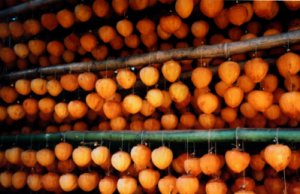
Winter weather here is (from November through to February) cold, sunny and, with a low humidity, ideal for a slow drying process.
(3) The partially dried Kot Kam is then shaped into a rough "doughnut" , the classic shape, (some other regions of Korea also have their own style) and put out in the sun to dry further.Note there is no forced, artificial drying employed at all.
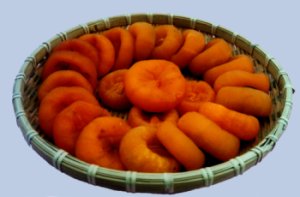
The Kyungungi (Korean tractor)
These machines have fascinated me ever since I arrived here.
They are totally adapted to the small rice fields and narrow tracks leading up to the Persimmon and Sweet Chestnut "orchards".
The are basically a single stroke diesel engine, two-wheel machine with a number of power take-off points too
which various implements such as ploughs,pumps and rotorvators can be attached.
The wheels can also be changed to a paddle-type more suited to rice fields. Steering is via a handlebar system which makes the tractor highly manoeuvreable in narrow spaces.
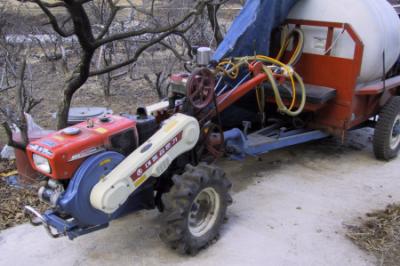
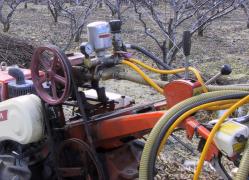
A typical configuration is shown above. A trailer is attached to the main take-off point and with the rear
wheels driven gives an effective four wheel drive setup.
In the above a small air compressor is fitted on the top and is
operated by the fan belt. This in turn powers the insecticide spray unit and is typical of the Kyungungi's versatility.
Below is a closer view of the connection between tractor and trailer.
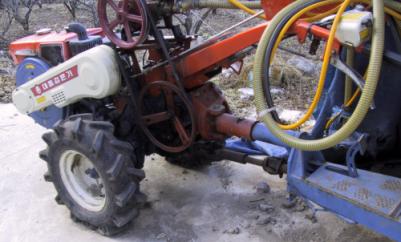
What they look like on the road!
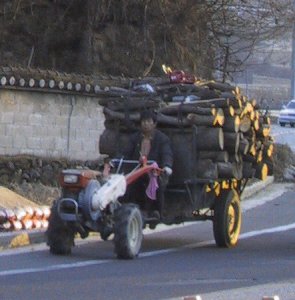
It's Spring - Fields need preparing so out comes the plough.
Here's a friend doing his field.
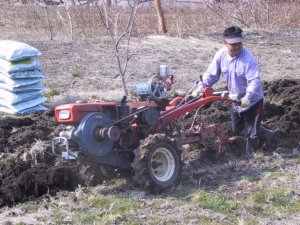
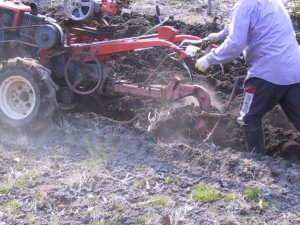
Kyungungi set up with a Rotovator to turn over dry soil.
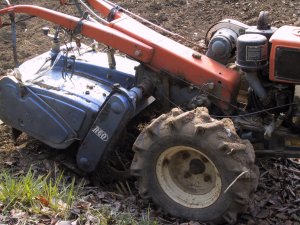
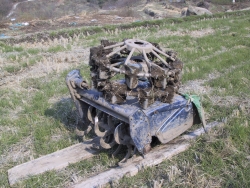
In this picture you can see the wheels that replace the road wheels for working in the wet rice field. The rotovator is used to prepare the saturated soil for planting the rice seedlings.
More pictures will be added during the year to show seasonal configurations.
Growing Rice
The other major crop grown is of course rice. Below is the life cycle of planting rice to this point in the year.
There are four major steps in the cycle.
- Prepare the fields by rotovating and flooding
- Grow the seedlings
- Plant the seedlings
- Wait for harvest
The four stages can be depicted more clearly with the following pictures:
| Preparing the fields.The field is saturated with water and then rotovated using a Kyungungi or normal tractor. After that the field is flooded with water and left until planting starts. | 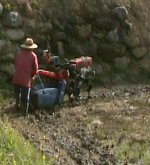 |
| Seeds are planted into trays (with soil), covered with a geotextile sheet and left to "sprout".After about 3 weeks the seedlings are ready to be planted. |  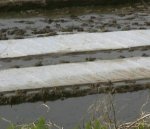
|
| Planting rice has had to become more mechanised due to a lack of people to do it manually. This principly because of the trend for the young people to move to the cities to work. Working on the farms is heavy, dirty work with not such a great reward at the end of the year. As such some of the farmers doing the work are quite old. For instance in the village where I live more than 65% of the total population is over the age of 60. There are still 70+ year olds doing working the land. In the next few pictures you can see the machine they use round here. |
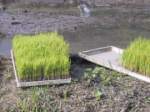
|
| A back view of the machine. | 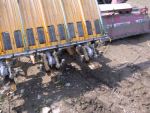 |
| The seedlings are removed from the trays en masse, rather like a carpet, and placed on the back of the machine.As the machine advances the rear "plate" moves to and fro horizontally plucking the seedlings in turn and placing them in the ground. Very clever! . | 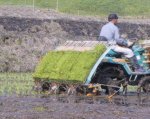 |
| After the machine has finished the field looks like this. The seedlings are spaced equidistant as close to the edge as possible. Some hand planting happens in tight corners the machine cannot reach. | 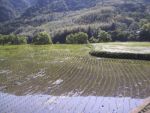 |
More pictures later in the year at harvesting time.
Agricultural Art
There used to be a small building in the village that was used as a central collection point for produce being moved on to be sold. On the wall of this building was painted a quite interesting mural. Unfortunately the building no longer stands. So I was lucky to take the pictures before it was knocked down.The mural was painted in three panels so I've cut out the non-relevant sections just to show the art.
As you look at the image in centre to left is a representation of the produce grown here, rice,persimmon and sweet chestnut.
Centre to right shows the people of the village ( one of the subjects has the name of the village on his hat) leading a charge. One of the two characters far right is Chinese and in the back the top hat of Uncle Sam is clearly visible.
The mural is quite old and was showing some signs or weather wear and the colours had faded a lot due to the sun.
Click the picture for a larger image.
Apparently the mural was painted some 30 years ago by some students. More on this later.



